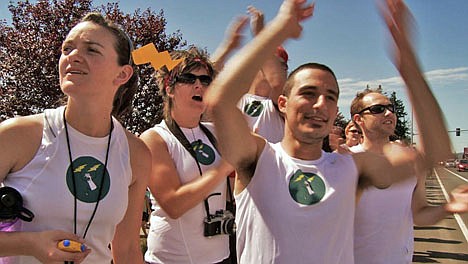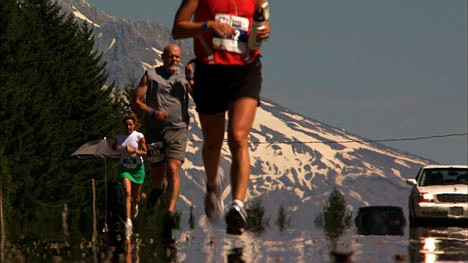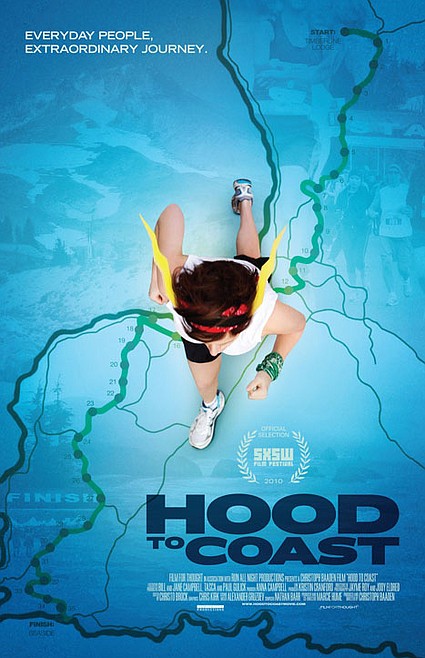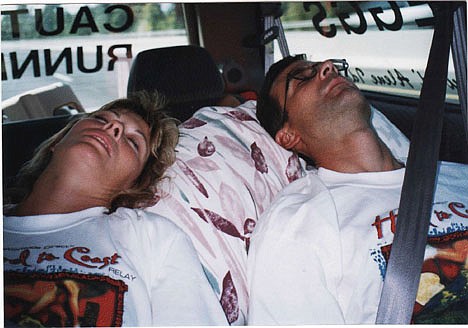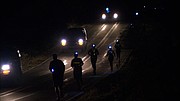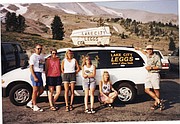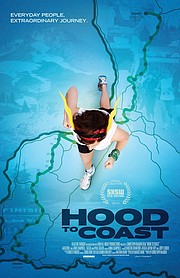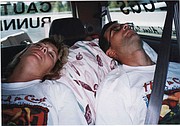'Attempting the extraordinary'
Eventually, Piper Freeman got used to the camera in her face.
She had to, because it wasn't going away. It was there when she ran, when she rested, when she ate and when she shouted encouragement to teammates.
It was there for 197 miles of the 2008 Hood to Coast relay as film crews followed Freeman's team of "Thunder and Laikaning" on their journey in what is billed as the world's largest relay race that begins at Timberline Lodge on Mt. Hood, elevation 6,000 feet, and ends at the Pacific Ocean in Seaside, Ore., elevation zero.
"They keyed right in on the fact we were not prepared at all," Freeman said with a laugh. "I think we were the comic relief, because the other teams they followed are really moving stories."
The resulting documentary of the race, "Hood To Coast," will be shown in a one-night event nationwide on Jan. 11, including at Regal Cinemas at Riverstone in Coeur d'Alene.
Freeman's is one of four teams featured in the film. The 2001 Lake City High School graduate was part of a team from Laika, an animation studio in Portland, where she worked at the time.
She's not sure why, but their 12-person team was selected to be followed throughout the two-day race where rest is rare as runners push through days and nights together.
"We were kind of a jumbled team," the 27-year-old Freeman said. "We were a mixed bag of people."
Animators, editors and bookkeepers took part in the journey with not a whole lot of training, said Freeman, who ran cross country her senior year "on a whim" at LCHS under coach Donna Messenger.
"I don't know that we were totally prepared for all of it," she said.
Freeman, who works in Oakland, Calif., for Pixar Animation Studios, called Hood to Coast a similar vibe to that cross country team. It was about many people sharing the same amazing adventure as one.
"Everybody is in the same pain together," she said, laughing.
The race
The annual Hood To Coast Relay began in 1982. That first year, it started with a group of runners "to stretch their legs and expand on the everyday running experience." Bob Foote, a Portland architect, and longtime runner organized a run from Timberline Lodge on Mount Hood to the Oregon Coast.
The idea was that 12 people would divide themselves into two groups of six, run three legs each and cover the nearly 200-mile distance from the mountain to the ocean. At first, each leg was 5 miles.
In 1982 eight teams ran, but within a decade, the race had grown to the point where they had to cap the number of teams at 1,000. The route shifted to avoid highways, and the exchange points became more than 5 miles apart.
"As the race grew to unprecedented proportions, they needed to find convenient stopping points for 2,000 vans that now wound their way through the Oregon countryside. More importantly, the race had become an adventure not only for serious athletes, but amateur runners and thrill seekers," according to a press release.
The race includes teams from all 50 states, and more than 50 countries send representatives.
Next year's 30th anniversary will be Aug. 26-27. The field was capped at 1,250 teams that paid a $1,320 entry fee. It filled with a lottery format in one day on Oct. 13.
The film
The "Hood to Coast" documentary recounts the adventures of four teams with various levels of ability in the 2008 race.
The 101-minute film will be shown in nearly 350 movie theaters on Jan. 11, including Regal at Riverstone, where it will be shown at 8:30 p.m.
Film For Thought, Inc. in association with Run All Night productions and producer Chistoph Baaden follows the teams "on their epic journey to conquer the world's largest relay race."
More than 1,000 teams and 12,000 runners compete in 197 grueling miles, "putting themselves through an arduous physical journey that as an individual would be impossible," according to a press release. "Some run to test their personal limits, some to overcome personal obstacles, and others leap in blindly looking for a way to shake up a complacent life.
"As we follow these four teams, we realize that winning isn't everything in a documentary that takes a celebratory look at personal motivation and attempting the extraordinary."
Tickets for the event are $12.50. See more at
www.hoodtocoastmovie.com
Lake City Leggs
Don Witulski of Coeur d'Alene organized a team called "Lake City Leggs," that competed in Hood to Coast" four years, the last in 2001.
"It is one of the neatest things I've ever done," he said.
Some years, they simply ran for fun. Others, they were competitive and finished fourth in the mixed masters division, averaging 7 minutes a mile throughout the 36 legs of the race.
"If you placed like we did, you got invited back. It's almost impossible to get in now," he said.
Witulski recalled he wanted to be part of Hood to Coast after he heard "how fun it was."
"I got tired of running against all the good people in town," he said. "I thought why not put them all on the same team."
Turns out, the running was the easy part. The logistics were a little more difficult. The race called for a budget of $3,000 to cover the entry fee, renting two vans, renting a house in Oregon and buying food, beside taking several days off from work.
Plus, you had to get along well with the other five teammates in a van, especially since you're often cranky due to lack of sleep. Then, there was the challenge of being prepared for the unexpected, like having a drunken driver sideswipe your van, which happened to Witulski one year.
Still, Witulski would do it again if he could put together a 50 and over men's team that could compete well.
"It is cool," he said. "The best part is the finish when you come into the sandy beach in Seaside. There's bands, dancing, the finish to me is the highlight. There's nothing like it."
Jim Wyatt of Coeur d'Alene competed on some of those teams with Witulski. He loved being on the Hood to Coast relay team.
"If you're really a runner and you love the outdoors, man, it's an event. It really makes you appreciate what you can do and where you're at," he said.
Wyatt ran the first leg of the relay for his team, which was a wild dash down Mt. Hood.
"That's exciting. You're starting it off and you're going fast, it's a little bit crazy," he said.
There was one year that he recalled a runner on another team died during relay. Wyatt saw the ambulance, but thought later that the man who died was with other runners and "doing what he loved to do in one of the most beautiful places in all of the West. That wasn't a bad way to go," he said.
Dick Stauffer, another member of the Lake City Leggs who competed in the relay three years, recalled "the oddness of being in a van for 24 hours with different people."
You pretty much, eat, sleep and breathe together, and forget about hygiene.
"As you get toward the end people get a little bit on the loopy side," he said, laughing. "Almost everything is fun."
He said the transition areas were particularly interesting.
"You end up with hundreds of people milling around, suffering from lack of sleep and nourishment, looking for places to go to the bathroom."
Would he do it again?
Yes, Stauffer said, although he would be more of a cheerleader than a racer.
And there would have to be one other consideration.
"I think I would with the right personalities," he said.
Piper's plans
Freeman plans to see Hood to Coast in Portland when it premiers Jan. 11.
She called being part of the 2008 relay - she ran about 17 miles in her three legs - and the documentary a great experience.
"Our goal was to finish," she said. "We did."
As team captain, the toughest part was keeping everyone motivated, being sure they were OK, eating, and well, alive.
Still, like others who have done it, she would do it again.
As a matter of fact, Freeman and a Pixar team applied to be part of the race next year, but weren't chosen in the lottery.
She said she'll never forget the moment during the 2008 relay when she was running about 3 a.m. It was quiet, dark other than her headlamp and she was surrounded by the forests of Oregon.
"It was absolutely beautiful," she said. "I looked up, I could see all the stars."
If you go
“Hood To Coast,” will be shown in a one-night event nationwide on Jan. 11, including at Regal Cinemas at Riverstone in Coeur d’Alene. Tickets are $12.50. Info: www.hoodtocoastmovie.com

